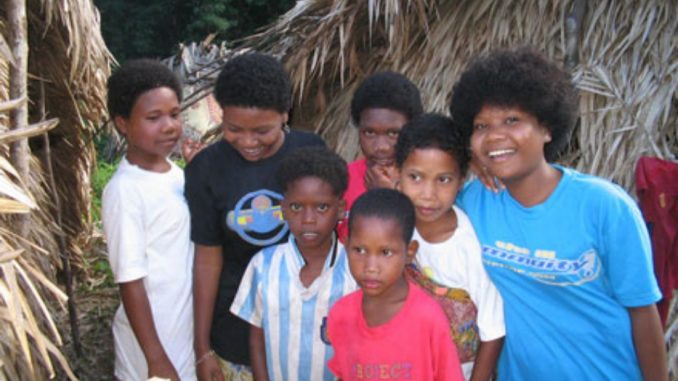
The Mani people are the original homo sapiens that traveled from Africa and settled in Thailand many years ago. They are the original negaritos who moved with other Africans like Andamanese of India, Aetas of Philippines,Semangs of Malaysia to their present residence in Thailand. They were there before the other ethnic groups came to form the Thai kingdom. Anthropological studies has revealed that the Thai Mani and Malaysian Semang were the first modern humans to enter the Malay peninsula. They remarked that “the original people of the Malay Peninsular that about 4,500 years ago the Proto-Malays moved south from the Yunnan province area of China into Southeast Asia where they met the Negritos who, for a long time, may have been the only modern humans to live in this area” and on the subject of prehistoric communities in southern Thailand that “the first Homo sapiens groups moving into the area after Homo erectus were of Negrito type, short build, black complexion and curly hair similar to the Australians.”
The name Mani is of Mon-Khmer origin and means “human being,” and they speak Tonga language. The Mani or “forest people” as other Thai people call them lives in the jungles of southern Thailand, in the Banthad Mountain Chain and around the Malaysian border in the provinces of Trang, Phatthalung and Satun. The Mani people “are of short build, black complexion” and “with curly hair. They are facing extinction and currently their total population is about 300. The Banthad Mountain chain became a base area for communist insurgents during the 1970s and thus a battle ground between communist guerillas and Thai government forces. Especially during the years of 1975-1977, the insurgents were battered in ground and air attacks. The Mani suffered terribly during this war with government forces frequently mistaking the smoke of Mani camp fires for insurgent activity. Those living in Trang and Phatthalung provinces had to move to the sanctuary of Thoungwan district in Satun province.
The Mani people lives in groups known as “bands.” Mani bands are made up of several families and usually comprise between 15 and 30 persons. They seem to regard this as the most convenient size for a band to make a living. Each family in a band has their thub or shack (which the Mani call ayah) as living quarters. Ayahs are built in a circle, all are facing inwards to form a circular village center. Normally, a band consists of parents, their children, and other close relatives such as nephews and nieces. The band is led by a chief elected by all adult members. Members of the band must follow the instructions of their chief. while youngsters are, of course, also expected to listen to their parents. A survey on the Mani living in the Trang forest area in December 1982 found that there were three groups:
1. the “Above Klong Thong River” band of 9 males and 6 females
2. the “Khlong Hindaeng River” band of 11 males and 7 females
3. the “Jaopha” band, of 9 males and 9 females.
By questioning them, we have learned that in Trang Province there had originally been 5 groups. Two of them had moved away:
4. Mr. Sung’s group from Ban Naitra village
5. Mr. Yung’s/Mrs. Yum’s group from the vicinity of Ban Hin Jork village had moved into the area of Manung in Satun Province.
Only three groups remained in the Trang village area in the early 1990s.
The “Jaopha” Band is quite different from the other Mani bands. This band is organised differently from the other groups. One difference is that the band is made up of members of families of elder brothers and sisters joining together. Another is that members of the band can marry each other as long as they are not blood relatives. Such practice is different from that of the other Mani where no marriage among band members is normally allowed. The “Jaopha” band in the early 1990s consisted of 5 families under the leadership of Mr. Khai who is brother-in-law to one member and uncle to other members of his band.
In Mani society there is no right, apart from tradition, to assert land ownership. Yet in their hunting-gathering activities, the bands hardly ever intrude into territories belonging to other bands. Members of a band learn early about the areas that they are allowed to use for themselves and force would not be used to expel or punish trespassers. At times where the land is not suitable for hunting or for collecting wild potatoes, “we live temporarily with other bands to share food with them.” (Mr. Loh, BE 2535 / AD 1992). In normal times, each Mani hunting band sticks to its own territory for hunting and gathering activities.
